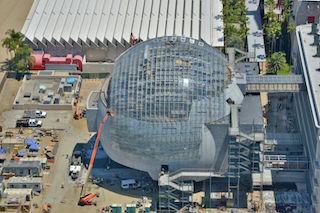 Construction has halted on the Academy Museum in Los Angeles in the wake of the global pandemic but its organizers still expect to be able to meet their previously announced opening date of December 14. "We are keenly aware that we're working towards the opening of the Academy Museum during a time of great challenge," said Bill Kramer, director of the Academy Museum of Motion Pictures.
Construction has halted on the Academy Museum in Los Angeles in the wake of the global pandemic but its organizers still expect to be able to meet their previously announced opening date of December 14. "We are keenly aware that we're working towards the opening of the Academy Museum during a time of great challenge," said Bill Kramer, director of the Academy Museum of Motion Pictures.
When it does open the Academy Museum promises to be the world’s premier institution dedicated to the art and science of movies. The museum will be simultaneously immersive, experimental, educational, and entertaining. More than a museum, this dynamic film center will offer unparalleled experiences and insights into movies and moviemaking.
Designed by Pritzker Prize–winning architect Renzo Piano, the museum is restoring and revitalizing the historic Saban Building—formerly known as the May Company building (1939)—at the corner of Wilshire Boulevard and Fairfax Avenue in Los Angeles. The Saban Building will feature six floors, including exhibition spaces, the 288-seat Ted Mann Theater, the Shirley Temple Education Studio, special event spaces, conservation areas, a café, and store. The new spherical addition will connect to the Saban Building via glass bridges and will feature the state-of-the-art 1,000-seat David Geffen Theater.
Kramer said, “Over the past century, motion pictures have reflected and impacted major historical issues and events. The stories we tell in the Academy Museum are part of those bigger stories, and we are committed to highlighting the social impact of motion pictures. We look forward to brighter days for everyone, everywhere.”
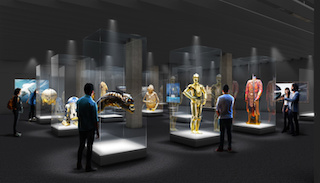 Kramer added that renowned cross-disciplinary design studio wHY Architecture has been retained to finalize the design of galleries spanning three floors in the museum’s Saban Building. The project is led by the director of wHY’s Museums Workshop Brian Butterfield and lead exhibition designer Jarrod Beck with creative direction from the studio’s founder Kulapat Yantrasast.
Kramer added that renowned cross-disciplinary design studio wHY Architecture has been retained to finalize the design of galleries spanning three floors in the museum’s Saban Building. The project is led by the director of wHY’s Museums Workshop Brian Butterfield and lead exhibition designer Jarrod Beck with creative direction from the studio’s founder Kulapat Yantrasast.
Ron Meyer, chair of the Academy Museum Board of Trustees and vice chairman of NBCUniversal said, “The Board of Trustees is extremely enthusiastic about how the exhibition, design, and programming plans for the Museum have developed. We very much look forward to movie lovers around the world experiencing the thoughtful and unprecedented content the Academy Museum has to offer when its doors open.”
Academy CEO Dawn Hudson added, “When our long-held dream comes true, and we open our doors to the world, the Academy’s vast collection will be on display to the general public for the first time. The Academy Museum will be an ongoing showcase for the creativity and ingenuity of today’s greatest moviemakers. We are thrilled to have Academy members and Oscar winners Spike Lee, Pedro Almodóvar, Hildur Guðnadóttir, and Ben Burtt participating in our opening exhibitions.”
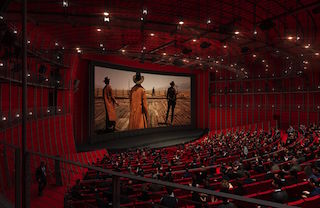 The core exhibition, housed on the second and third floors, will be Stories of Cinema. It will include galleries developed with filmmakers Spike Lee and Pedro Almodóvar, Academy Award-winning composer Hildur Guðnadóttir and Academy Award-winning sound designer Ben Burtt.
The core exhibition, housed on the second and third floors, will be Stories of Cinema. It will include galleries developed with filmmakers Spike Lee and Pedro Almodóvar, Academy Award-winning composer Hildur Guðnadóttir and Academy Award-winning sound designer Ben Burtt.
The exhibition experience of the Academy Museum will begin in the Grand Lobby of the Saban Building with the Spielberg Family Gallery—which is open to the public without charge. This soaring, glass-walled gallery will serve as an introduction to the museum’s exhibitions by surrounding visitors with multiple screens featuring a rapid immersion into the history of cinema, from the Lumière brothers to present day.
Continuing to the second and third floors, visitors will discover the 31,000 square-foot, two-floor core exhibition Stories of Cinema in the Rolex and Wanda Galleries. Stories of Cinema will connect audiences to the celebratory, complex, diverse, and international history of motion pictures. All aspects of the arts and sciences of moviemaking will be explored in the Stories of Cinema galleries, which, like cinema itself, will evolve and change over time—highlighting different movies, artists, eras, genres, and more.
Adopting the approach that there is no single narrative tied to the development of cinema, this exhibition will showcase multiple stories from a variety of voices and perspectives. Within Stories of Cinema, a gallery devoted to The Wizard of Oz takes visitors behind the scenes of this classic movie to explore the many disciplines that made this film come to life—screenwriting, casting, make-up design, costume design, production design, sound design, special effects, acting, directing, producing, and more. Connected to this experience will be galleries that dive deeper into the worlds of casting and performance; the creation of identity through costume, hair, and makeup design; the various components of sound design; the creation of story; and the work of cinematographers.
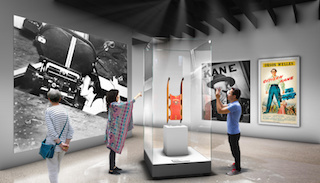 Other Stories of Cinema galleries will be devoted to showing how worlds and characters are created in science fiction and fantasy movies through the collaborative work of production designers, visual effects artists, and costume designers; how documentaries and narrative movies reflect and impact social issues; hand-drawn, stop-motion, and digital animation; a history of the Academy Awards; and significant moments in cinema history as told though a diverse array of vignettes spotlighting movies and movie artists such as Bruce Lee, Emmanuel “Chivo” Lubezki, Oscar Micheaux, Citizen Kane, and Real Women Have Curves.
Other Stories of Cinema galleries will be devoted to showing how worlds and characters are created in science fiction and fantasy movies through the collaborative work of production designers, visual effects artists, and costume designers; how documentaries and narrative movies reflect and impact social issues; hand-drawn, stop-motion, and digital animation; a history of the Academy Awards; and significant moments in cinema history as told though a diverse array of vignettes spotlighting movies and movie artists such as Bruce Lee, Emmanuel “Chivo” Lubezki, Oscar Micheaux, Citizen Kane, and Real Women Have Curves.
On both floors, visitors will be surrounded by moving images, sound, props, costumes, scripts, posters, production and costume design drawings, matte paintings, photographs, backdrops, animation cels, puppets, maquettes, and more. While Stories of Cinema will celebrate and champion the stories, art, and artists of cinema, complex and difficult stories also will be told.
Adjacent to Stories of Cinemas will be three immersive experiences. Visitors will experience advanced and iconic moviemaking technologies firsthand in the Hurd Gallery, a dramatic, 34-foot double-height space. The Hurd Gallery’s inaugural installation will feature the original multi-camera rig from The Matrix, directed by Lana and Lilly Wachowski. Visitors will be able to learn about the history of this technology and how the film’s Oscar-winning visual effects—led by visual effects supervisor John Gaeta—were made. Also, they will have the opportunity to reenact their own “Bullet Time” moment on a recreation of the original green screen set.
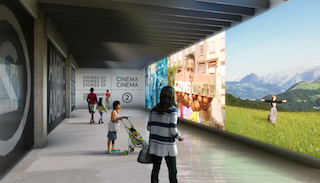 Located on the third floor in the East West Bank Gallery, the Oscars Experience will create an immersive environment that simulates the experience of visitors walking onto the stage at the Dolby Theatre in Hollywood and accepting an Oscar. Also located on the third floor will be a gallery devoted to special collections. This space will open with an exhibition that explores the foundation of cinema, featuring a collection of pre-cinema objects, including magic lanterns, zoetropes, camera obscuras, a Cinématographe Lumière, and more.
Located on the third floor in the East West Bank Gallery, the Oscars Experience will create an immersive environment that simulates the experience of visitors walking onto the stage at the Dolby Theatre in Hollywood and accepting an Oscar. Also located on the third floor will be a gallery devoted to special collections. This space will open with an exhibition that explores the foundation of cinema, featuring a collection of pre-cinema objects, including magic lanterns, zoetropes, camera obscuras, a Cinématographe Lumière, and more.
On the fourth floor, the 11,000-square-foot Marilyn and Jeffrey Katzenberg Gallery will be dedicated to a regularly changing series of large-scale temporary exhibitions. The debut temporary exhibition Hayao Miyazaki is curated by the Academy Museum in collaboration with Miyazaki’s Studio Ghibli. Taking visitors on a journey into the enchanted and complex world of Miyazaki’s animated movies, this will be the first major retrospective of his work in the Americas. Using original production materials from Studio Ghibli’s archives, many of which are leaving Japan for the first time, the exhibition will present more than 300 concept sketches, character designs, storyboards, layouts, cels, backgrounds, film clips, and immersive environments. This exhibition represents the first time that Studio Ghibli has collaborated with an outside organization to curate a show on Hayao Miyazaki.
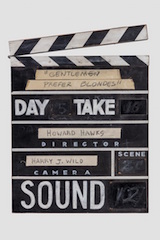 Following Hayao Miyazaki, in Fall 2021 the Academy Museum will present Regeneration: Black Cinema 1898–1971, exploring the history, artists, and visual culture of Black cinema in America and its manifold expressions from its early days to the Civil Rights movement and just beyond. Regeneration will be the first exhibition of its kind: a research-driven, in-depth look at Black participation in American filmmaking.
Following Hayao Miyazaki, in Fall 2021 the Academy Museum will present Regeneration: Black Cinema 1898–1971, exploring the history, artists, and visual culture of Black cinema in America and its manifold expressions from its early days to the Civil Rights movement and just beyond. Regeneration will be the first exhibition of its kind: a research-driven, in-depth look at Black participation in American filmmaking.
Through its collections, long-term exhibitions, temporary and traveling exhibitions, publications, and programs, the Academy Museum is committed to representing the diversity and scope of cinema history. The museum is working closely with its Inclusion Advisory Committee, chaired by producer and CEO of Gamechanger Effie Brown, to ensure that museum content is inclusive for all visitors. In addition, the museum is working with representatives from all 17 branches of the Academy’s membership to develop and refine museum content and programming related to the expertise of each branch.
